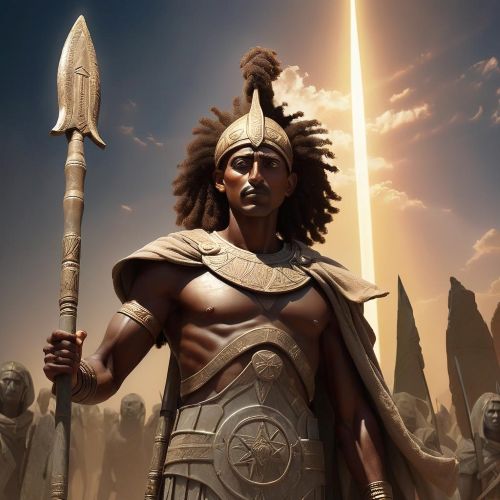Aksumite Mythology
Aksumite mythology reflects the spiritual and cultural beliefs of the ancient Kingdom of Aksum, a powerful civilization that thrived in present-day Ethiopia and Eritrea between the 1st and 8th centuries CE. Deeply influenced by indigenous African traditions, South Arabian culture, and later by Christianity, the mythology of Aksum offers a fascinating glimpse into a society that stood at the crossroads of Africa, the Middle East, and the Mediterranean. Unlike the well-documented mythologies of Greece or Egypt, Aksumite mythology is not preserved in a single text but rather pieced together through inscriptions, oral traditions, archaeological findings, and historical accounts. It reveals a pantheon of gods, ancestral spirits, and cosmic forces that shaped how the Aksumites understood their world, their rulers, and their destiny.
Central to Aksumite mythology was the worship of deities such as Maher, the god of war, and Beher, associated with the sea. These figures played vital roles in the lives of the Aksumites, reflecting their reliance on trade, conquest, and natural forces. Maher in particular was revered as the divine protector of kings, reinforcing the sacred authority of Aksumite rulers. The mythology also included sky and earth deities, fertility spirits, and ancestral beings who connected the people to their past. The Aksumites practiced elaborate rituals, sacrifices, and offerings at temples and sacred sites, underscoring the significance of myth in maintaining social and political order. With time, especially after the adoption of Christianity in the 4th century CE under King Ezana, these mythological beliefs were gradually absorbed or reinterpreted within Christian narratives, creating a unique fusion of ancient African spirituality and biblical tradition.
The mythology of Aksum was not just a collection of stories but also a tool of legitimacy and identity. Kings often linked themselves to divine ancestry or claimed favor from gods to strengthen their rule. Inscriptions and coins bearing symbols such as the disc and crescent highlight the sacred dimension of Aksumite authority. Oral traditions, still alive among communities in Ethiopia and Eritrea, preserve fragments of these ancient myths, merging them with later Christian legends and folklore. For example, tales of sacred mountains, miraculous victories, and divine interventions remain part of the cultural memory, reflecting how Aksumite mythology evolved while still influencing local identities. This blending of old and new demonstrates the resilience of Aksumite beliefs, ensuring they were never entirely erased despite religious and political transformations.
Today, Aksumite mythology continues to intrigue historians, archaeologists, and cultural enthusiasts who seek to understand the roots of Ethiopian civilization and its enduring spiritual heritage. Sites such as the stelae fields of Aksum, the ancient obelisks, and the remnants of temples offer tangible connections to this mythology, while legends of the Ark of the Covenant being housed in Aksum highlight the deep intertwining of myth and faith. Exploring Aksumite mythology provides not only insights into a once-great African empire but also into the universal human need to explain the world through stories of gods, ancestors, and cosmic power. By studying these myths, we gain a clearer understanding of how the Aksumites viewed life, death, and the divine, and how their spiritual legacy continues to shape the cultural identity of the Horn of Africa today.


